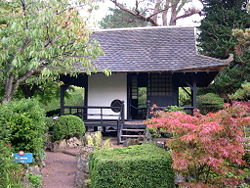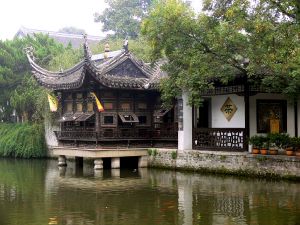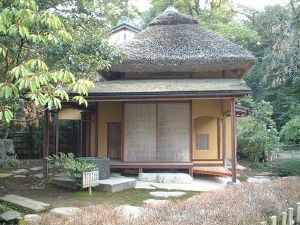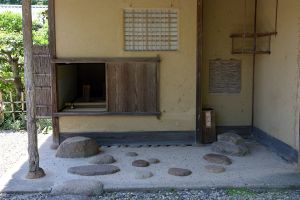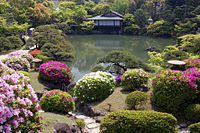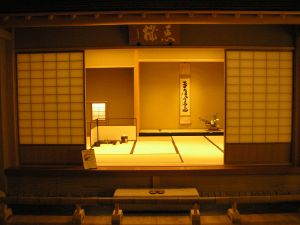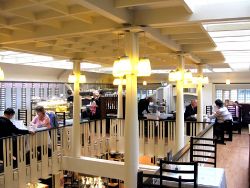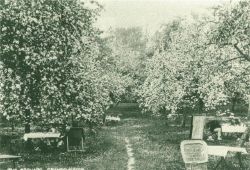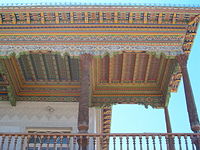Difference between revisions of "Tea house" - New World Encyclopedia
(→Japan) |
(→Japan) |
||
| Line 35: | Line 35: | ||
Tea rooms are also usually small, and are found inside tea houses as well as in private homes, [[temples]] or [[shrines]], schools, and other institutions. In Japanese homes, any room with a [[tatami]] floor may be used as a tea room; but the same room may also be used for other purposes. | Tea rooms are also usually small, and are found inside tea houses as well as in private homes, [[temples]] or [[shrines]], schools, and other institutions. In Japanese homes, any room with a [[tatami]] floor may be used as a tea room; but the same room may also be used for other purposes. | ||
| − | |||
Tea houses are purpose-built structures where Japanese tea ceremonies are performed. The smallest tea house has two rooms: a tea room and a ''[[mizuya]]'', where the host prepares the sweets and [[List of Japanese tea ceremony equipment|equipment]], and may have a total floor area of only two or three [[tatami|mats]]. | Tea houses are purpose-built structures where Japanese tea ceremonies are performed. The smallest tea house has two rooms: a tea room and a ''[[mizuya]]'', where the host prepares the sweets and [[List of Japanese tea ceremony equipment|equipment]], and may have a total floor area of only two or three [[tatami|mats]]. | ||
| Line 51: | Line 50: | ||
[[Image:Meimeian08n4592.jpg|right|thumb|Small entrance ''nijiri-guchi'' of a tea house]] | [[Image:Meimeian08n4592.jpg|right|thumb|Small entrance ''nijiri-guchi'' of a tea house]] | ||
| + | [[Image:Sorakuen14st3200.jpg|thumb|200 px|"Sorakuen" in Kobe, Hyogo prefecture, Japan]] | ||
A typical tea house is surrounded by a small [[Japanese garden|garden]]. In the garden there will be a waiting area for guests, as well as a [[roji]] (路地), or "dewy path" leading to the tea house. | A typical tea house is surrounded by a small [[Japanese garden|garden]]. In the garden there will be a waiting area for guests, as well as a [[roji]] (路地), or "dewy path" leading to the tea house. | ||
The tea house itself is usually built of wood and bamboo, and the only entrance and exit is a small, square door which symbolically separates the small, simple, quiet inside from the crowded, overwhelming outside world. Tea houses usually consist of two rooms: one used for the preparation of food, snacks and tea supplies, and the other for the holding of the tea ceremony itself. The main room is typically extremely small, often 4 1/2 ''[[tatami]]'' mats, and the ceilings are low. There is no furniture, except for that which is required for the preparation of tea. There will usually be a charcoal pit (炉, ''ro'') in the center of the room for boiling water for tea. | The tea house itself is usually built of wood and bamboo, and the only entrance and exit is a small, square door which symbolically separates the small, simple, quiet inside from the crowded, overwhelming outside world. Tea houses usually consist of two rooms: one used for the preparation of food, snacks and tea supplies, and the other for the holding of the tea ceremony itself. The main room is typically extremely small, often 4 1/2 ''[[tatami]]'' mats, and the ceilings are low. There is no furniture, except for that which is required for the preparation of tea. There will usually be a charcoal pit (炉, ''ro'') in the center of the room for boiling water for tea. | ||
| Line 59: | Line 59: | ||
All doors and windows are traditional Japanese ''[[shoji|shōji]]'', made of thin strips of balsa wood covered in a translucent [[washi|Japanese paper]] which allows light from outside to come into the room. The floor is built a few feet above the ground in order to keep the room dry. These features are still common not only in houses and inns in the traditional style but also in ordinary residences. | All doors and windows are traditional Japanese ''[[shoji|shōji]]'', made of thin strips of balsa wood covered in a translucent [[washi|Japanese paper]] which allows light from outside to come into the room. The floor is built a few feet above the ground in order to keep the room dry. These features are still common not only in houses and inns in the traditional style but also in ordinary residences. | ||
| − | + | ||
| − | [[Image:Museum für Ostasiatische Kunst Dahlem Berlin Mai 2006 016.jpg|thumbnail|thumb|Interior view of a tea room]] | + | [[Image:Museum für Ostasiatische Kunst Dahlem Berlin Mai 2006 016.jpg|thumbnail|thumb|Interior view of a traditional tea room]] |
The acknowledgment of simplicity and plainness, which is a central motivation of the tea house, continued to remain as a distinct Japanese tradition in the later periods. | The acknowledgment of simplicity and plainness, which is a central motivation of the tea house, continued to remain as a distinct Japanese tradition in the later periods. | ||
Typical tea houses and tea rooms have a ''ro'' (hearth), ''tokonoma'' and two or three entrances. There are at least two entrances, one for guests and one for the host. The entrance for guests, called ''nijiri-guchi'', connects the tea room and the outside. The other entrance connects the tea room and ''mizuya'' and is used by the host and any assistants. Some tea rooms have a third entrance, called ''kinin-guchi'' (lit. "entrance for the nobility"), which is only used by high-ranking people such as [[daimyo]]. The ''toko'' (lit. "floor") is an alcove where the host displays flowers or calligraphy, which may be admired during the course of the ceremony. To enable the appreciation of these objects, as well the tea utensils themselves, tea rooms often have windows. However traditional tea rooms seldom have a wide window, since the dimly-lit room helps the participants to concentrate on the ceremony itself. A hearth is set in the floor, never on the wall or in the alcove, and is used in all seasons. | Typical tea houses and tea rooms have a ''ro'' (hearth), ''tokonoma'' and two or three entrances. There are at least two entrances, one for guests and one for the host. The entrance for guests, called ''nijiri-guchi'', connects the tea room and the outside. The other entrance connects the tea room and ''mizuya'' and is used by the host and any assistants. Some tea rooms have a third entrance, called ''kinin-guchi'' (lit. "entrance for the nobility"), which is only used by high-ranking people such as [[daimyo]]. The ''toko'' (lit. "floor") is an alcove where the host displays flowers or calligraphy, which may be admired during the course of the ceremony. To enable the appreciation of these objects, as well the tea utensils themselves, tea rooms often have windows. However traditional tea rooms seldom have a wide window, since the dimly-lit room helps the participants to concentrate on the ceremony itself. A hearth is set in the floor, never on the wall or in the alcove, and is used in all seasons. | ||
| − | |||
| − | |||
[[Image:Ichiriki front.jpg|thumb|left|The entrance of the Ichiriki Ochaya]] | [[Image:Ichiriki front.jpg|thumb|left|The entrance of the Ichiriki Ochaya]] | ||
Revision as of 21:12, 10 December 2008
- "Tearoom" redirects here.
A tea house or tearoom is a venue centered on drinking tea. Their function varies widely depending on the culture, and some cultures have a variety of distinct tea-centered houses or parlors that all qualify under the English language term "tea house" or "tea room."
History
Asia
China
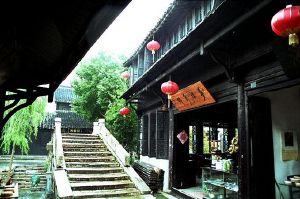
In China, a tea house (茶馆, "cháguăn" or 茶屋, "cháwū") is traditionally quite similar to the American "cafe," albeit centered around tea rather than coffee. People gather at tea houses to chat, socialize, and enjoy tea. Young people often meet at tea houses for dates. Especially, the Guangdong (Cantonese) style tea houses are very famous abroad, such as in New York, San Francisco and other major cities. these tea houses not only serve tea, but also dim sum (点心), people can eat different kinds of food when they drink tea. People call these kinds of tea house named “茶楼, chálou.”
The ritualized drinking of tea is often practiced in China. The most important work on tea making is the Cha Jing. It is the only extant work of the Tang Dynasty scholar and poet Lu Yu and was written during the 700s. He describes many aspects of tea making from the location of the teahouse to the mode of drinking. His treatise is considered definitive by many.
In Northern Imperial China teahouses were regarded as retreats for gentlemen and later for businessmen. Deals would be discussed and sealed in the neutral, relaxed surroundings of a teahouse rather than in offices.
Tea houses were and are places where disputes could be settled harmoniously over tea. Courts of law are not spots where most people feel at ease. The Chinese at times replaced this setting with a tea house and the presence of a mutually respected arbiter. The disputing parties would agree on terms and apologies, pay for the tea, shake hands, and part in peace. In the same way that insurance agencies and stock brokerages in England developed out of simple coffee shops, tea houses in China were (and still are) used as places to conduct business.
Some tea houses in Hong Kong still uphold such a tradition and are frequented by Hong Kong Chinese industrialists and entrepreneurs. Traditional tea houses can still be found in the older communities. One example is the Luk Yu Teahouse in Central Hong Kong.
Japan
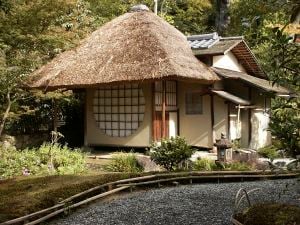
In Japanese tradition a tea house (茶室, chashitsu lit. "tea room") can refer to a structure designed for holding Japanese tea ceremonies. Tea rooms for tea ceremonies, whether they comprise an independent structure or one room within a larger architectural structure, are also called chashitsu in Japanese. The architectural space called chashitsu was created for aesthetic and intellectual fulfillment.
In Japanese tradition, rooms where tea ceremonies are performed are known as chashitsu (茶室, literally "tea room"). There are two types of chashitsu: free-standing structures often containing several rooms (known as tea houses in English), and rooms located within dwellings or other buildings and set aside for tea ceremony (known in English as tea rooms).
Tea houses are usually small, simple wooden buildings. They are traditionally located in remote, quiet areas, but today are more likely to be found in the gardens or grounds of larger houses, or in public or private parks.
Tea rooms are also usually small, and are found inside tea houses as well as in private homes, temples or shrines, schools, and other institutions. In Japanese homes, any room with a tatami floor may be used as a tea room; but the same room may also be used for other purposes.
Tea houses are purpose-built structures where Japanese tea ceremonies are performed. The smallest tea house has two rooms: a tea room and a mizuya, where the host prepares the sweets and equipment, and may have a total floor area of only two or three mats.
Very large tea houses, such as those that can be found in some parks in Japan or those maintained by large tea schools, such as Urasenke, may have several tea rooms of different sizes; a large, well-equipped mizuya resembling a modern kitchen; a large waiting room for guests; a welcoming area where guests are greeted and can remove and store their shoes; separate toilets for men and women; a changing room; a storage room; and possibly several anterooms. Such tea houses can accommodate dozens of guests and several simultaneous tea ceremonies, and may have a total floor area exceeding sixty mats.
Whatever the size of the tea house, however, it will be built from simple, rustic materials and be scrupulously maintained and kept spotlessly clean.
The design of tea houses is heavily influenced by Zen philosophy. Tea houses were first introduced in the Sengoku period, a time in which the central government had almost no practical power, the country was in chaos, and wars and uprisings were commonplace. Seeking to reclaim Japan, samurai were busy acquiring and defending territories, promoting trade and overseeing the output of farms, mills and mines as de-facto rulers, and many of the poor were eager to seek the salvation of the afterlife as taught by Buddhism.
Tea houses were built mostly by Zen monks or by daimyo, samurai, and merchants who practiced the tea ceremony. They sought simplicity and tranquility - central tenets of Zen philosophy.
A typical tea house is surrounded by a small garden. In the garden there will be a waiting area for guests, as well as a roji (路地), or "dewy path" leading to the tea house. The tea house itself is usually built of wood and bamboo, and the only entrance and exit is a small, square door which symbolically separates the small, simple, quiet inside from the crowded, overwhelming outside world. Tea houses usually consist of two rooms: one used for the preparation of food, snacks and tea supplies, and the other for the holding of the tea ceremony itself. The main room is typically extremely small, often 4 1/2 tatami mats, and the ceilings are low. There is no furniture, except for that which is required for the preparation of tea. There will usually be a charcoal pit (炉, ro) in the center of the room for boiling water for tea.
Guests and hosts sit seiza style on the floor. There is usually little decoration. There will be a tokonoma (scroll alcove) holding a scroll of calligraphy or brush painting, and perhaps a small, simple, flower arrangement called a cha-bana (茶花). All materials used are intentionally simple and rustic.
All doors and windows are traditional Japanese shōji, made of thin strips of balsa wood covered in a translucent Japanese paper which allows light from outside to come into the room. The floor is built a few feet above the ground in order to keep the room dry. These features are still common not only in houses and inns in the traditional style but also in ordinary residences.
The acknowledgment of simplicity and plainness, which is a central motivation of the tea house, continued to remain as a distinct Japanese tradition in the later periods.
Typical tea houses and tea rooms have a ro (hearth), tokonoma and two or three entrances. There are at least two entrances, one for guests and one for the host. The entrance for guests, called nijiri-guchi, connects the tea room and the outside. The other entrance connects the tea room and mizuya and is used by the host and any assistants. Some tea rooms have a third entrance, called kinin-guchi (lit. "entrance for the nobility"), which is only used by high-ranking people such as daimyo. The toko (lit. "floor") is an alcove where the host displays flowers or calligraphy, which may be admired during the course of the ceremony. To enable the appreciation of these objects, as well the tea utensils themselves, tea rooms often have windows. However traditional tea rooms seldom have a wide window, since the dimly-lit room helps the participants to concentrate on the ceremony itself. A hearth is set in the floor, never on the wall or in the alcove, and is used in all seasons.
In Japan a tea house (お茶屋, ochaya) can also refer to a place of entertainment with geisha, the most notable of which is the Ichiriki Ochaya. These kinds of tea houses are typically very exclusive establishments.
The Ichiriki Ochaya (translated Ichiriki Teahouse) is one of the most famous and historic Ochaya in Kyoto (note that Ochaya are distinct from Chashitsu). It is located on Shijo-dori Street near the heart of the district of Gion, and is considered an exclusive and high-end establishment, access is invitation only and entertainment can cost upwards of 800,000 yen a night.
The Ichiriki Ochaya is over 300 years old, and has been a major centerpiece of Gion since the beginning of the entertainment district. Like other Ochaya in Gion, the Ichiriki was a place where men of status and power went to be entertained by Geisha, who distracted guests through dancing, banter, and flirtation. The Ichiriki has tradtitionally entertained those of political and business power.
United Kingdom
In the United Kingdom, a tearoom is a small room or restaurant where beverages and light meals are served, often catering chiefly to women and having a sedate or subdued atmosphere. A customer might expect to receive cream tea or Devonshire tea, often served from a china set, and a scone with jam and clotted cream – alternatively a High tea may be served. In Scotland teas are usually served with a variety of scones, pancakes, (Scottish) crumpets and other cakes. Tearooms are often adorned with bird cages filled with exotic birds to create a relaxing atmosphere.
Thomas Twining opened the first known tea room in 1706, which remains at 216 Strand, London today. In 1787 the company created its logo, still in use today, which is thought to be the world's oldest commercial logo that has been in continuous use since its inception (Standage 2006). Under Associated British Foods since 1964, Stephen Twining now represents the company's ten generations. In 2006, Twinings celebrated its 300th anniversary, with a special tea, and associated tea caddies. Twining's is a Royal Warrant holder (appointed by HM The Queen).
The popularity of the tearoom rose as an alternative to the pub during the temperance movement in the 1830s. The form developed in the late 1800s, as Catherine Cranston opened the first of what became a chain of Miss Cranston's Tea Rooms in Glasgow, Scotland. Miss Cranston had conceived the idea of a series of "art tearooms," venues where people could meet to relax and enjoy non-alcoholic refreshments in a variety of different "rooms" within the same building. She worked together with internationally renowned architect Charles Rennie Mackintosh to design her tea rooms, which a a result made available a unique, avant-garde artistic world to thousands of ordinary people, with the result that their tea rooms became internationally famous. The last and most famous of these establishments, the Willow Tearooms on Sauchiehall Street with its famous "Room de Luxe" stretching the width of the building above the main entrance and front tearoom, opened for business in October 1903 and, following substantial renovation in the 1980s, remains open today.
While other cities offered very expensive and very basic tea rooms by 1901, Miss Cranston set the standard in Glasgow for more welcoming establishments. Rooms were provided for ladies only and for gentlemen only, as well as luncheon rooms where they could dine together and smoking rooms and billiards rooms for the gentlemen. Miss Cranston's Tea Rooms became social centers for all, for businessmen and apprentices, for ladies and ladies' maids. The Ladies Rooms were a particular success, newly allowing respectable women to get out and meet together without male company. Following her success, similar establishments opened throughout Scotland.
There is a long tradition of tea rooms within London hotels. In the 1880s fine hotels in both the United States and England began to offer tea service in tea rooms and tea courts, and by 1910 they had begun to host afternoon tea dances as dance crazes swept both the U.S. and the UK. Tea rooms of all kinds were widespread in Britain by the 1950s, but in the following decades cafés became more fashionable, and tea rooms became less common.
A well known chain of tea shops was those of Joseph Lyons and Co., which were originally opened 1894 and finally closed in 1981. The tea shops were slightly more up-market than their Aerated Bread Company counterparts. A.B.C. as it became known is mostly remembered for its chain of self-service tea-rooms of which the first opened in 1865. At its peak in 1923 it had 150 branch shops in London and 250 tea rooms. The Lyons tea shops were notable for their interior design, Oliver P. Bernard being consultant artistic director. Before the Second World War service was to the table by uniformed waitresses, known as "Nippies," but after the War the tea shops converted to cafeteria service. Until the 1940s they had a certain working-class chic, but by the 1950s and 1960s they were quick stops for busy shoppers where one could get a cup of tea and a snack or a cheap and filling meal. The tea shops always had a bakery counter at the front, and their signs, art nouveau gold lettering on white, were a familiar landmark.
The Orchard is a tea garden in Grantchester, near Cambridge which opened in 1897. A popular retreat for Cambridge students, teachers, and tourists, it includes many famous names among its patrons. The history of The Orchard started in 1897 when a group of Cambridge students asked the landlady, Mrs Stevenson of Orchard House, if they could take their tea in the orchard rather than on the front lawn as the custom was. This practice soon became the norm, and the place grew in popularity. The next phase in the history of The Orchard began when the poet Rupert Brooke took up lodging in the house in 1909. A graduate student of great popularity in the university community at the time, Brooke soon attracted a great following at the place, among them Virginia Woolf, John Maynard Keynes, E. M. Forster, Bertrand Russell, Augustus John, and Ludwig Wittgenstein – the so-called Grantchester Group. Today the Orchard is open every day of the year and can be reached both by road from Cambridge or by punt down the River Cam.
Bettys and Taylors of Harrogate, a Swiss-Yorkshire family company with seven locations in North Yorkshire, England. Bettys Café Tea Rooms are traditional tea rooms serving traditional meals with influences both from Switzerland and Yorkshire. The first Bettys tea room was opened on Cambridge Crescent in Harrogate, North Yorkshire, by Frederick Belmont, a Swiss confectioner, in July 1919. The Harrogate tea rooms later moved to their current position on Parliament Street.
In a related usage, a tearoom may be a room set aside in a workplace for workers to relax and (specifically) take refreshment during work-breaks. Traditionally a staff member serving food and beverages in such a tearoom would have been called a tea lady.
United States
Tea houses and tea rooms in the United States range from the whimsical Alice's Tea Cup in New York City, where patrons sit at mismatched tables and chairs or lounge on floral banquettes, to the Dushanbe Tea House in Boulder, Colorado, a gift from the sister city of Dushanbe—the capital of Tajikistan—created by over 40 artisans and featuring a hand-carved and hand-painted ceiling, tables, stools, columns, and exterior ceramic panels.
Another notable institution is New York's venerable Russian Tea Room, a full service restaurant opened in 1927 by former members of the Russian Imperial Ballet as a gathering place for Russian expatriates and which became famous as a gathering place for those in the entertainment industry. Food has always been considered second to the Russian Tea Room's décor—perpetually decked in festive red, green, and gilt with red carpet, red leather banquettes and chairs, eclectic artwork and antique samovars, and etched-glass revolving door—although caviar has always been featured. After being sold, renovated, closing, and being sold again in the twenty-first century, the Russian Tea Room continues to be an iconic landmark of New York city (Kilian 2006).
Other
Around the world, the term "tea house" or "tea room" may be used to refer to a restaurant or Salon de Thé. In the twenty-first century they are thriving, from individual tea houses to franchises with establishments in many cities and even countries, they offer a variety of teas and atmospheres in which to enjoy them. For many, the atmosphere and experience itself is paramount, while for others the quality of the tea and its various beverages are the attraction. Following are some examples.
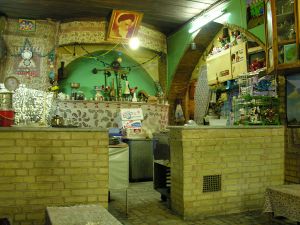
In the Middle East, notably in Iran and Turkey, they may be referred to as Chaee-Khaneh—literally, the "house of tea." These tea houses usually serve several beverages, (tea, coffee), and some serve Hookah.
Dobra Cajovna (also Dobrá Tea, Dobrá čajovna) is a tea house franchise originating in the city of Prague in the Czech Republic, but which has since opened in many other cities around the world including (at the time of this writing) two US locations, one in Burlington, Vermont and a second in Madison, Wisconsin. Dobrá (meaning "good" in Czech) specializes in serving fine loose-leaf teas brewed and served expertly in the manner of each tea's country of origin. The staff (known as Tea Devotees) are specially trained for all the varieties of tea they carry, and are very careful with water temperature and steeping time to try for the best possible cup. There is a diverse selection of teas available, from Indian chai and Darjeeling to Chinese white tea, pu-erh and Japanese matcha. Aside from the tea itself, Dobra's atmosphere is uniquely peaceful when compared to the typical American coffeehouses and tea houses. Rather than promoting the "cup-on-the-run" routine so common in US cities, Dobra's calming music, dim lighting, and friendly staff emphasize the idea of mindfulness with every sip. Also served are pastries, couscous with fruit, spiced pita, and other snacks to compliment the beverages.
- Tajikistan
There are many tea houses in Tajikistan. They are traditionally decorated with Persian art, lavish decoration and color, and the use of motifs from nature. They serve as social places where friends gather to talk or play chess while drinking tea.
- Egypt
In Egypt, coffee houses are called 'ahwa' and combine serving coffee as well as tea and tisanes. Tea is called shai, and coffee is also called ahwa. Karkady, or Hibiscus tea, the infusion made from the calyces (sepals) of the Hibiscus sabdariffa flower, is also popular.
ReferencesISBN links support NWE through referral fees
- Standage, Tom. 2006. A History of the World in 6 Glasses. New York, NY: Walker Publishing Company. ISBN 978-0802715524
- Kinchin, Perilla. 1998. Taking Tea with Mackintosh: The Story of Miss Cranston's Tea Rooms. Pomegranate Communications. ISBN 0764906925
- Richardson, Bruce. 2008. The Great Tea Rooms of Britain. Perryville, KY: Benjamin Press. ISBN 978-0979343117
- Richardson, Bruce. 2008. Great Tea Rooms of America. Perryville, KY: Benjamin Press. ISBN 978-0979343155
- Pettigrew, Jane, and Bruce Richardson. 2008. The New Tea Companion. Perryville, KY: Benjamin Press. ISBN 978-0979343179
- Gautier, Lydia. 2006. Tea: Aromas and Flavors Around the World. San Francisco, CA: Chronicle Books. ISBN 978-0811856829
- Heiss, Mary Lou, and Robert J. Heiss. 2007. The Story of Tea: A Cultural History and Drinking Guide. Berkeley, CA: Ten Speed Press. ISBN 978-1580087452
- Kilian, Cynthia. 2006. 'Russian' Back: Famed Tea Room Set to Reopen New York Post, October 30, 2006. Retrieved December 9, 2008.
- "Introduction to oriental civilizations: Sources of the Japanese Tradition." Columbia University Press: New York 1958
- Verley, Paul. "Japanese Culture." 4th ed. Updated and Expanded. University of Hawaii Press. 2000
- Murphey, Rhoads. "East Asian: a new History." 2nd ed. Addison-Wesley Educational Publishers 2001
External links
- Boulder Dushanbe Tea House
- Aerated Bread Company (ABC) National Archives.
| ||||
| Black tea | Blended and flavored teas | Chinese tea | Earl Grey tea | Green tea | Herbal tea | Lapsang souchong | Masala chai | Mate tea | Mint tea | Oolong tea | Turkish tea | White tea | Yellow tea | ||||
| Tea culture | Related to tea | |||
| China | India | Japan | Korea | Morocco | Russia | United Kingdom | United States | Samovar | Tea house | Teapot | Tea set | |||
Credits
New World Encyclopedia writers and editors rewrote and completed the Wikipedia article in accordance with New World Encyclopedia standards. This article abides by terms of the Creative Commons CC-by-sa 3.0 License (CC-by-sa), which may be used and disseminated with proper attribution. Credit is due under the terms of this license that can reference both the New World Encyclopedia contributors and the selfless volunteer contributors of the Wikimedia Foundation. To cite this article click here for a list of acceptable citing formats.The history of earlier contributions by wikipedians is accessible to researchers here:
The history of this article since it was imported to New World Encyclopedia:
Note: Some restrictions may apply to use of individual images which are separately licensed.
